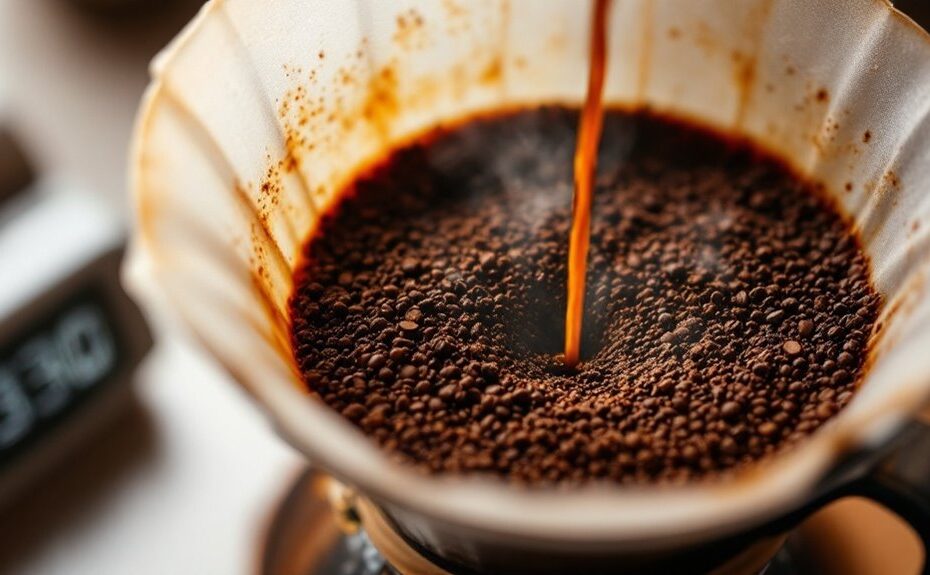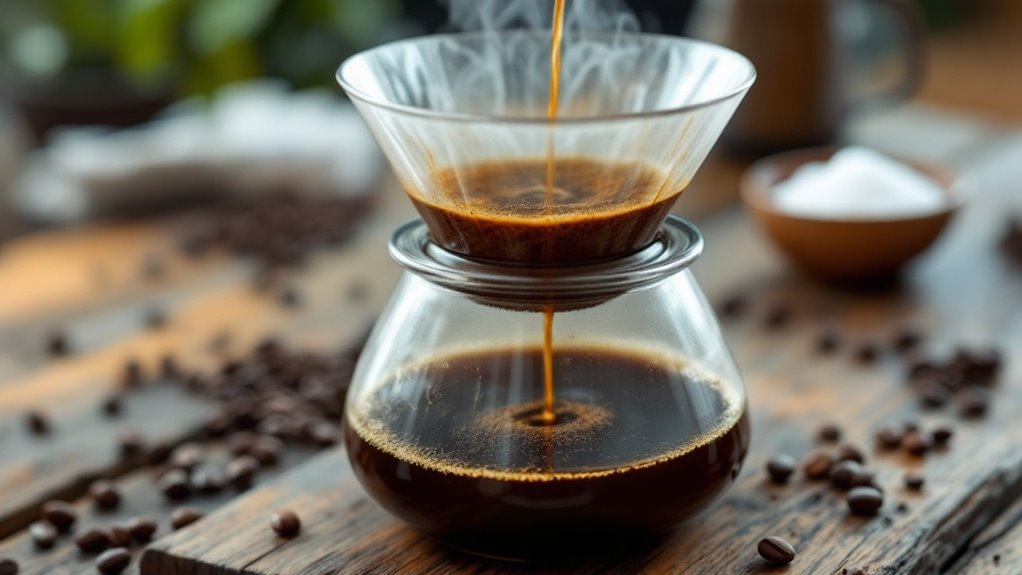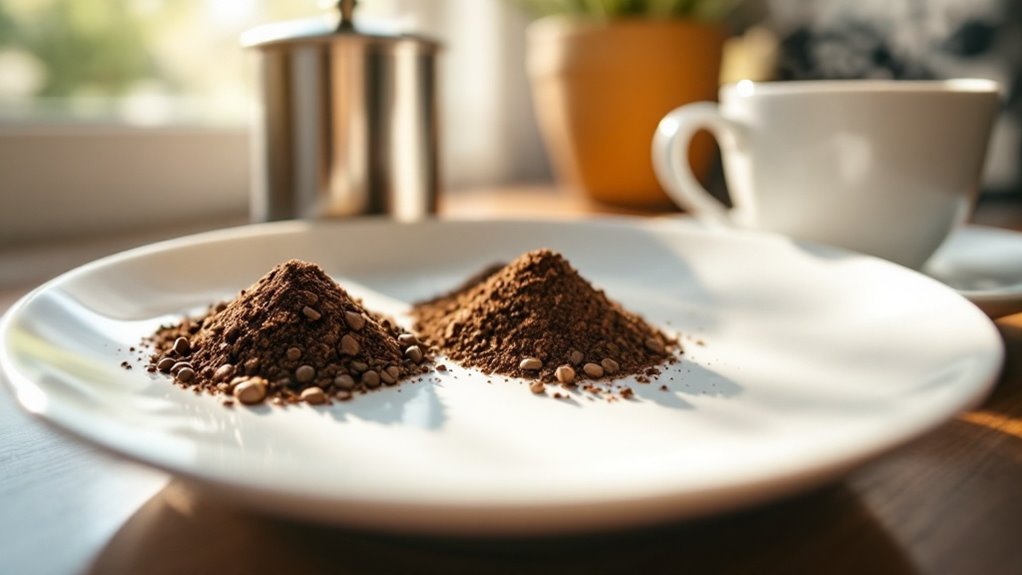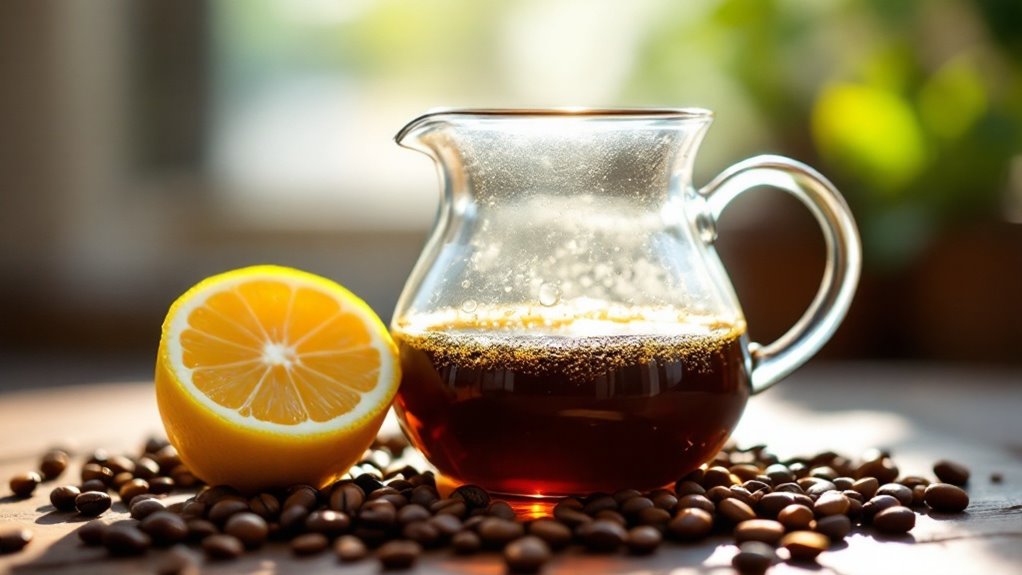







You might think brewing coffee is as simple as adding water to grounds, but the time you let it steep makes all the difference. Brew too quickly, and you'll end up with a cup that's sour or flat, missing the depth of flavor you crave. Let it sit too long, and bitterness takes over, masking the subtle notes you worked so hard to reveal. The key lies in finding that sweet spot, where every second counts. But how do you know when you've hit it? The answer might just change the way you approach your morning ritual.
Key Takeaways
- Shorter brew times (under 20 seconds) cause under-extraction, resulting in sour, weak, and salty flavors.
- Longer brew times (over 45 seconds) risk over-extraction, leading to bitter, astringent flavors from excessive tannins.
- Ideal brew time balances sweetness, acidity, and bitterness, with extraction yields between 18-22% for optimal flavor.
- Brew time varies by method: espresso (25-30 seconds), French Press (4-5 minutes), and pour-over (2.5-4 minutes).
- Adjusting grind size and dose directly impacts brew time, fine-tuning extraction for desired taste and balance.
The Science of Coffee Extraction
When you brew coffee, you're fundamentally extracting soluble compounds from the grounds into water. This process, known as coffee extraction, relies on the interaction between water and coffee grounds to dissolve desirable compounds like sugars, acids, and aromatic oils. The goal is to achieve an extraction yield between 18-22% of the coffee's mass, as this range balances sweetness, acidity, and bitterness. If extraction falls below 18%, you'll notice sour or salty flavors due to insufficient dissolution of sugars and acids. Conversely, exceeding 22% leads to bitter, astringent flavors as water dissolves undesirable compounds like tannins and polyphenols.
Brewing time plays a critical role in coffee extraction. Shorter brewing times risk under-extraction, leaving behind undissolved compounds that contribute to a flat or unbalanced flavor. Longer brewing times, however, can over-extract the coffee grounds, pulling out too many bitter elements. The interaction between water and coffee grounds during brewing is a delicate balance—too little time, and the water doesn't fully penetrate the grounds; too much time, and it extracts compounds that overwhelm the flavor. Understanding this relationship helps you control the extraction process and achieve a more balanced cup.
Optimal Brewing Time for Different Methods
The brewing time for coffee varies considerably depending on the method used, directly influencing the flavor profile and extraction efficiency. For French Press Coffee, a brew time of 4 to 5 minutes is ideal, allowing the coarse grounds to steep fully and produce a rich, full-bodied cup. If you're using a drip coffee maker, aim for a brew time of 5 to 6 minutes to guarantee even extraction and a clean, balanced taste. Espresso, on the other hand, requires a much shorter brew time of 25 to 30 seconds, as the high pressure and fine grind size facilitate rapid extraction of concentrated flavors. Pour-over methods typically take 2.5 to 4 minutes, depending on grind size, to highlight delicate, nuanced notes. Cold brew, a slow and low-temperature brewing method, demands 12 to 24 hours of steeping to achieve a smooth, low-acidity coffee with subtle sweetness. Each brewing method has a most effective brew time that maximizes extraction efficiency while balancing flavor, so adjusting your technique to match these guidelines secures a consistently satisfying cup.
Impact of Brew Time on Flavor Profiles
Your brew time directly impacts extraction, determining whether you achieve a balanced cup or one dominated by extremes. Shorter times (under 20 seconds) often under-extract, leaving you with sour, weak notes, while longer times (over 45 seconds) risk over-extraction, introducing bitterness and astringency. For ideal flavor balance, aim for a brew time that extracts solubles evenly, typically between 25-35 seconds, to highlight sweetness and complexity without overpowering acidity or bitterness.
Brew Time and Extraction
Brew time plays a pivotal role in shaping the flavor profile of your coffee, directly influencing the balance between sweetness, acidity, and bitterness. When you adjust brew time, you control the rate and extent of extraction, which determines how much flavor compounds dissolve from the coffee beans into your cup. Shorter brew times, such as 18 seconds, often lead to under-extraction, producing lighter, brighter flavors with sour or salty notes. Conversely, longer brew times, like 45-60 seconds, risk over-extraction, resulting in bitter, astringent flavors. For espresso, an ideal brew time typically falls between 25-35 seconds, ensuring a balanced extraction that harmonizes sweetness, acidity, and bitterness. Grind size also interacts with brew time; finer grinds increase surface area, speeding up extraction, while coarser grinds slow it down. Preinfusion, a technique that extends contact time before full pressure, can enhance extraction mechanics, improving flavor balance. By fine-tuning brew time alongside grind size, dose, and machine pressure, you optimize extraction to highlight the desired flavors in your coffee beans.
Flavor Balance Over Time
Adjusting brew time directly impacts the flavor balance in your coffee, shaping how sweetness, acidity, and bitterness interact. Shorter brewing times, such as 18-25 seconds for espresso, often result in under-extraction, producing bright, acidic flavors but lacking depth. Conversely, longer brew times, like 45-60 seconds, risk over-extraction, leading to bitter, astringent notes that overpower the coffee's natural sweetness. For ideal flavor, aim for a brew time of 25-35 seconds in espresso or 2.5-4 minutes in pour-over methods. These durations allow for balanced extraction, where sweetness, acidity, and bitterness harmonize without dominating the cup. In immersion brewing, such as with a French press, a 4-5 minute brew time extracts a full-bodied, rich flavor while minimizing bitterness. Each brewing method has a sweet spot where time aligns with extraction to highlight the coffee's unique characteristics. By experimenting with brew time, you can fine-tune the taste of your coffee, ensuring a balanced flavor profile that suits your preferences. Precision in timing is key to revealing the full potential of your coffee's flavor.
Adjusting Brew Time for Desired Taste
To achieve your desired taste, adjust the grind size finer to extend brew time or coarser to shorten it, directly influencing extraction intensity. Control dose and flow rate to fine-tune the balance between acidity, sweetness, and bitterness, ensuring ideal flavor development. Incorporate preinfusion techniques, especially for lighter roasts, to enhance extraction uniformity and reveal nuanced, complex flavors.
Grind Size Adjustments
By altering the grind size, you directly influence the brew time and, consequently, the flavor profile of your coffee. A finer grind size increases the surface area exposed to water, slowing its flow and extending the brew time. This enhances extraction, intensifying flavors and often leading to a richer, more complex cup. However, over-extraction can result in bitterness if the brew time is too long. Conversely, a coarser grind size reduces surface area, speeding up water flow and shortening the brew time. This yields lighter, less extracted flavors, but under-extraction can leave your coffee tasting sour or weak. Adjusting the grind size by just one setting can shift the brew time by 5-10 seconds, greatly impacting the flavor balance. For espresso, aim for a grind size that achieves a 25-30 second brew time to guarantee ideal extraction and a harmonious blend of sweetness, acidity, and bitterness. In pour-over methods, a medium grind size with a 3:30-4 minute brew time promotes even extraction, delivering a clean, nuanced taste. Fine-tuning grind size is key to achieving your desired coffee tastes.
Dose and Flow Control
When you increase the dose of coffee grounds, you'll notice the brew time extends as water takes longer to permeate the denser coffee bed, enhancing extraction and intensifying flavors. A higher dose creates more resistance, slowing the flow rate and allowing for greater contact time between water and coffee particles. Conversely, reducing the dose speeds up the brew time, as water flows more freely through the less compacted bed. To maintain consistency, pair dose adjustments with grind size changes—finer grinds increase resistance and extend brew time, while coarser grinds reduce resistance and shorten it. For example, an 18g dose with a fine grind typically yields a 25-30 second brew time for a balanced espresso shot. Monitoring flow rate is critical; too fast, and you risk under-extraction, leading to sourness; too slow, and over-extraction can cause bitterness. By calibrating dose, grind size, and flow rate, you achieve precise control over brew time, ensuring ideal extraction and a well-rounded flavor profile. This balance is key to tailoring your coffee's taste to your preferences.
Preinfusion Techniques
Preinfusion techniques allow you to manipulate brew time and extraction by controlling how water initially interacts with coffee grounds. During preinfusion, you wet the grounds with a small amount of water, typically for 5-10 seconds, before applying full pressure. This step guarantees even saturation, reduces channeling, and enhances flavor uniformity. For lighter roasts, extending preinfusion to 15 seconds improves extraction by allowing deeper saturation, minimizing sourness, and balancing acidity. Conversely, for darker roasts, a shorter preinfusion of 3-5 seconds prevents over-extraction, which can lead to bitterness. Preinfusion pressure, usually set between 2-4 bars, gently hydrates the puck without forcing water through too quickly, securing ideal extraction. By adjusting preinfusion time and pressure, you fine-tune the brew time, balancing acidity, sweetness, and bitterness in the final cup. Experiment with these variables to tailor the flavor profile to your preference, guaranteeing a consistent and well-extracted brew every time. Preinfusion is a critical step in achieving a balanced and nuanced coffee experience.
Common Mistakes in Brewing Time Management
Many coffee enthusiasts overlook the critical role of brewing time, leading to common mistakes that substantially impact flavor. One frequent error is failing to adjust your brew time based on your grind setting. If you use a fine grind and brew your coffee for too long, over-extraction occurs, pulling out bitter and astringent compounds. Conversely, a coarse grind paired with a short brew time results in under-extraction, leaving your coffee weak, sour, or salty. Another mistake is ignoring the recommended brewing time for your chosen method. For example, a French Press typically requires 4 minutes; deviating from this can lead to unbalanced flavors. Inconsistent timing between brews also affects the taste, as even minor variations can disrupt the extraction process and create unpredictable results. To avoid these pitfalls, always match your grind size to your brew time and adhere to method-specific guidelines. Precision in timing guarantees you extract the ideal balance of flavors, enhancing the quality of your coffee.
Tools and Techniques to Perfect Brew Time
Mastering brew time requires the right tools and techniques to achieve consistent, high-quality results. Start by using a digital scale to measure your coffee grind and water precisely, ensuring an ideal ratio for brewing coffee. A gooseneck kettle is essential for pour-over methods, as its controlled pour maintains consistent contact time between water and coffee, preventing over- or under-extraction. Pair this with a timer or smartphone app to track brew time accurately, starting the moment water hits the grounds. Adjust your grind size incrementally—finer grinds slow extraction under high pressure, while coarser grinds speed it up, allowing you to fine-tune flavor. For methods like espresso, higher temperatures and high pressure demand a precise grind to balance extraction time. Regularly clean and maintain your equipment to avoid clogs or inconsistencies that disrupt brew time. By combining these tools and techniques, you'll achieve a balanced extraction, revealing the full potential of your coffee's flavor profile.
Disclosure: As an Amazon Associate, I earn from qualifying purchases.







